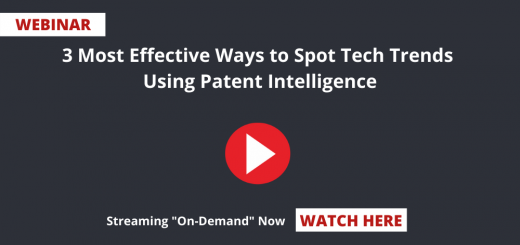How Can a Technology Evaluation Report (TER) Help You? – Webinar
Table of Contents
Key-points covered in this webinar session (Technology Evaluation Report)
- Overview of the Technology Evaluation Report.
- What are the critical parameters to consider while creating technology evaluation report?
- How to identify potential challenges and opportunities for an innovative business idea?
- Why is IP one of the crucial parameters while considering an innovative business idea?
- How recommendations from the technology evaluation report help you to plan your business decisions.
Key-note Speaker
Yogesh Soam, Senior Patent Analyst (SE), Engg. Searching, Sagacious IP
Anchor
Faiz Wahid, Regional Head – Sales (Europe), Sagacious IP
Submit Your Information to watch the Webinar Video:
Webinar Transcript
Faiz Wahid speaking: welcome to the webinar. This is Faiz Wahid, Regional Head Europe. I’m signing in from the Netherlands, and I welcome you all on this webinar on “How can Technology Evaluation Report Help You“.
To begin with, let me tell you that Sagacious, we work across multiple areas, including patent search, monetization, prosecution, paralegal and trademark support, drafting, training, and IT for IP and this particular webinar falls under the patent search area. And I have with me today, Mr. Yogesh Soam, who is a Senior Patent Analyst from the Engineering Searching Team at Sagacious IP. He has been an engineering graduate, and he is having specialization in the mechanical domain with interest in the field of automobile, 3D printing, and mobile technologies. He has more than three years of experience in the IP domain, and he has experience in managing the idea of patent searching projects, particularly those involving technology evaluations as well. So welcome to the Webinar Yogesh .
Yogesh speaking: thank you for having me on this webinar.
Faiz speaking: good to have you, Yogesh and it’s also a wonderful opportunity to have many attendees joining us from different parts of the world.
We have been hosting these webinars since last year. Since, Covid started, we have been doing them more, more, and more, and using it as a medium to share our knowledge in the IP space so that it helps peers in the industry.
These webinars have been a way of raising awareness and spreading knowledge that is honed by Sagacious for several years of working with different inventors, IP organizations, IP departments, and IP law practices.
In this webinar today, Yogesh will be sharing how technology evaluation reports can help one who is either an inventor or a business decision-maker to evaluate a particular technology.
Without taking more time, let me ask you, why you felt at this particular area was an interesting area to present and share our knowledge on. So you guess what is your view on it?
Yogesh speaking: well, thank you for asking. Hello, everyone. I hope you’re all doing well. Now moving on to the question first, I think technology evaluation – you see technology evaluation reports provide details about the technology that is under review its advantages and its shortcomings.
It also assess the value of the technology. I think that is the main aspect of the technology evaluation report. So the business can identify the value in technology.
Faiz speaking: okay, you mean to say that how we can evaluate a particular technology to assess its value and impact on a particular company’s, business or society also?
Yogesh speaking Yes
Faiz speaking: so that’s great. I think we can move ahead with some slides that you have. I’m sure you want to share it as you speak. In the meantime, let me also invite our listeners and participants to keep sharing their questions when they have them during this session. Also, please feel free to share your questions while we go to the webinar question box on the right side of this presentation window, I will pick up on those questions and ask them to our speakers after they finish their talk.
And the participants of this webinar can also drop us an email later on [email protected] if they need any particular details of this event and also if they need any of the samples, examples, documents, et cetera that are being referred within this webinar.
So let us now get started with the main part of our presentation. And for that, let me write your guest to take us through the webinar, over to you.
Yogesh speaking: before we move on to the webinar, let me just share a disclaimer that Sagacious IP does not own any of the logos or cut out that we have provided in webinar, and these are just for illustration and educational purposes only. And further, the data shown in this webinar is mostly electric from official websites, databases and WWW.
Now, after we call the Disclaimer, we can move on to the technology evaluation report. Now before we move on to the Technology evaluation report,
Let me showcase some successful startups. These are just a few examples of startups.

Okay, and as you can see, we only see the successful startup in today’s user in today’s world. We do not see how many startups have failed. Okay, so before I diverge into the webinar, I would like to ask you guys.
So what do you think approximately is the percentage that start-up fails?
I think I have shared that question on the webinar.
Now after the percentage of a startup is the next question that I will be asking you is the primary cause of the startup failure. Okay, so after you have provided your response in this, I will share the second question and then we can move on to the webinar.
Now, nearly all of you guys are voted and I will be moving on to the second question. That is what, in your opinion, is the primary cause of this startup failure?
You can work on this question now. Now, your response to the first question that around 90 percent startup fails and you guys are right of the status fails and only 10% succeeds.

And although that 10% that succeed, normally comprises a unicorn that will cover all the losses that are incurred by these startups. Okay, these are just a few insights that are collected from the research platforms. And this just focus on how many startups fails.
Reasons for Startup Failure
Now moving on to the primary cause of the startup failure.
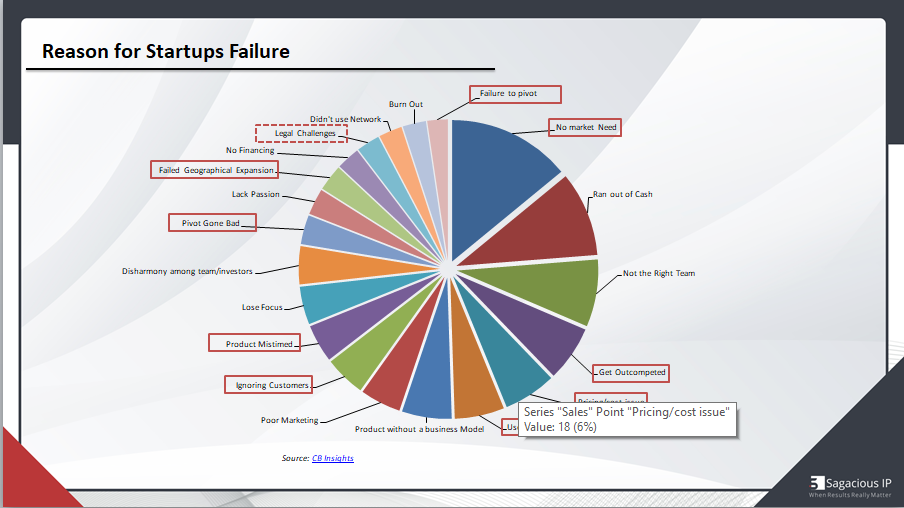
43% of you guys think that funding issues are the primary cause of the start of failure. 29% that it is the competition in the domain, and some feel that there is no customer need, making products that no one wants.
Now, Let’s just see what is actual stat says. So you see, the no market need as stated by the 29% of you guys, is the primary cause of startup failures.
Secondary forward ran out of cash. That is the funding issue that 43% of you voted. So you see the market need. That is the main primary course you see that is making a product that no one wants or there’s no need in the market.
Now in Technology Evaluation report can help you counter many of these challenges.
Okay, these include failure to private, gets out, competed for pricing at course issues, and user and friendliness or ignoring customer’s needs. So technology evaluation reports can help you mitigate these causes to solve these classes to some extent.
Okay, now moving on to the first post.
What is Technology Evaluation?
Okay, so technology evaluation is a set of principle methods techniques two for effectively assessing the potential value of a technology that is the identifying what is the value in technologies and what it contributes to your company, a region or industrial sector, or a society.
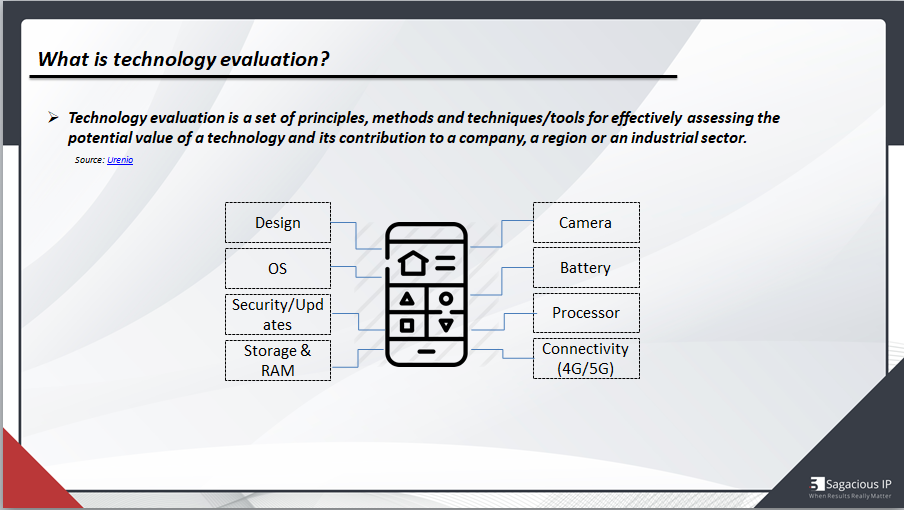
Now, let me explain this more simply.
So let us take an example of mobile guys, so you see before you buy them. While you consider various parameters, you may consider the design aspect of that mobile phone you will consider the operating system that the phone is using. You might also consider the security and updates the phone will provide over the years the storage and RAM option on that phone.
Also, consider the camera, battery processing capability, and connectivity options as well. You see, most of you guys are buying upon you, evaluate that particular product or technology based on some parameters. So that is generally what an evaluation means. Okay, evaluation is to assess technology and based on some type of specific parameters.
Okay, now moving on to a report. Technology evaluation report present information to the audience for a specific purpose. Now the audience for the TER can be inventors, innovators, patent returnees, smaller and medium enterprises, or generally anyone with an idea or an idea creator.
Purpose of the Technology Evaluation Report?
It is to assess the value of the technology and secondary to assess the impact of the technology in a particular company, region, or sector.
Case Study
Okay, now to understand the need for PR, let us do a case study. First. We will go through the case study and at the end of the case study, I will ask you guys a question.
So moving on to the case study guides, consider this an inventor, who has an idea for iPad racing. he wanted to develop an iPad racing wheel. He has created a prototype in the market set idea for you.
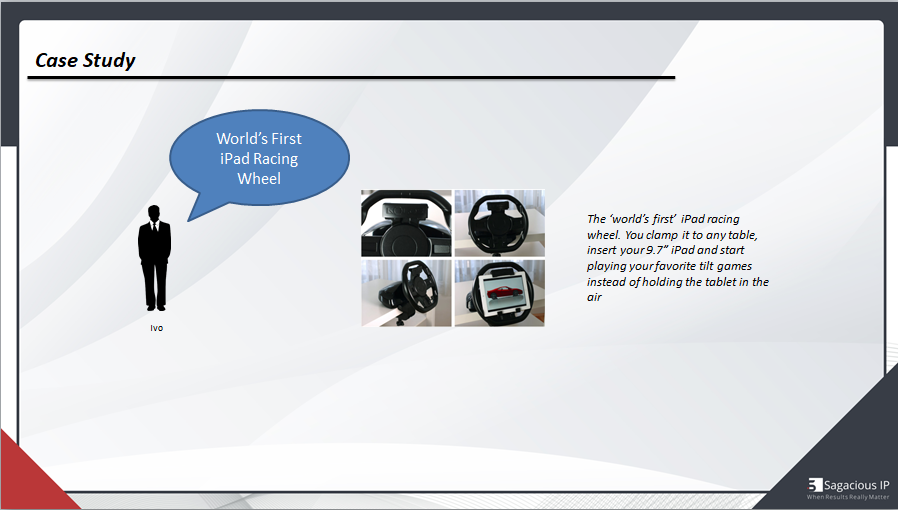
Okay, he comes for investment. The market is ideal as a wall first iPad racing wheel, which can be claimed to any table And after that, you can insert your iPad onto it and you can play your games. so after that, he also showcases some data to support his prototype or support his idea.
Okay, he shares with you the sales data of an iPad that is within the year 2018. Only you can see that there were around 14 million iPad sold worldwide. , and with the iPad shows, the accessories market is also increasing. And we also showcase few accessories that are being sold on the Apple website.
Currently, these are a few of the accessories that have been sold on the Apple website, will you consider investing in this invention or this idea?
Okay, so around 32 percent would have invested in this idea and 60 percent would have not. So let’s see what happened with this idea. So you see, the product called the company that created this product was KOLOS.
He prepared funding and loans. Okay, and then he just created an industrial design of the product. Okay, after that, he created a prototype, and then he moved on to the product launch step where he launched his product on the Indigo website that is out 100 dollars apiece and Unfortunately, no one bought it. And later he participated in the building hardware accelerator completion. And after that, he started in the year 2015.
That is, after three years of his idea conception, he started in Kickstarter campaign. And after the Kickstarter campaign, they raised around 4,000 dollars. And after the Kickstarter campaign, the company closed. So company close was that there was no market made for the product.
Okay, that no one wanted the product. That was a major cause of the failure of this startup and this could have been avoided, as we have seen in the Technology Evaluation Report or the reasons in the start of pages is there no marketed for the product which could be identified by Technology Evaluation Report.
Now, I think that this will correlate with you guys better when we move on to the new section of a Technology Evolution Report,
Now, the first point that will be covering in need of a Technology Evaluation Report is time and cost-saving.
How Technology Evaluation Report Can Save Your Time and Cost?
When an idea is presented to you or when you start investing in an idea, you just do not invest the money. You also invest your time and your resources as well. And if that idea is not feasible and you are investing the money is continuously going on later at the later stage, you are just leaving the idea.
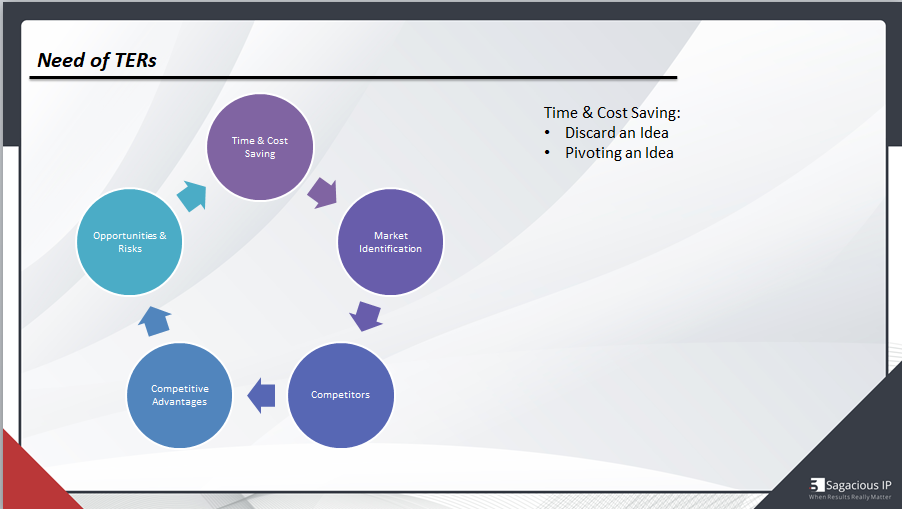
It is better to conduct a technology evaluation study before so that you can see the valuation of the technology and you can discard the idea early on rather than spending your time and cost and resources on that idea.
Or in another case, you can pivot the idea. That is, in case any improvement is requiring the Idea and Technology Evaluation Report can help you identify that improvement area as well, and you can pivot on time so that you can save time and cost and identifying other alternative solutions.
Now, the second is market identification
Technology Evaluation Reports will help you identify a correct market for the technology in the right consumer empires for that particular technology approved.
Next is the Competitors
Technology Evaluation Reports will identify competitors. and you can study those competitors. as well and you can learn from those competitors.
Technology Elevation Report will also provide you with the products that are being shared by those that are being implemented by those operators and the features of that particular product.
Competitive Advantage
as we have done from the competitor section, that Technology Evaluation Report will provide you with a list of competitors and their products. Then you can assess how your technology advantages those technologies that have been shared by the competitors, and you can use that to your advantage.
Opportunities Entries
Technology Evolution or can help you identify other application areas for the technologies that you might have missed And they will also help you identify potential risk in terms of IP or any other risk as well, or technical risk as well. So this is a business or an inventor need technology evaluation report.
Okay, so after that, we can move on to the technical evaluation report of experience in producing technology valuation report and give and there’s a basic format of the basic critical information that should be included in a technology evaluation report And we will be covering those in the next section.
Before we move on to that particular section, as you can see, we provide the technology evaluation for different kinds of information.
So how this information is procured or how where this information comes from. The information that comes from all the research that is done to prefer this information can be categorized into two categories- Primary and secondary
Okay, so primary research is that in which the data is the origin. So the researchers that are working on the technology evaluation Port that data is it’s own.
You can connect the interview with the technical aspects of that particular technology to know their opinion. You can also provide your observations. Okay, so those will be considered as primary research
In secondary research, We use the data that is already published by someone else or use someone else’s primary research to support our own limit or support our technology.These may include reports, books, and government data, and much more that I have not covered here But this is to give you a general idea of what kind of research is conducted to create a technology evaluation report.
Now moving on to the critical aspects of a technology evaluation report. Okay, so this is just a basic structure of a technology evaluation report, and we will be covering those sections one by one in details
And I also shared an example report to view that will be so tracing here so that you can understand those points.
Executive Summary
Traditionally, the executive summary provides a glimpse of the information that is provided in the details in the detail in the report.
Now the executor summary will provide detail about the background of the mention. Okay, so in this example, we have taken binder jetting as an example in getting the type of additive manufacturing process.
I think you guys know what an additive manufacturing process is. In case you don’t, I will explain
Let me just say additive manufacturing is a layer manufacturing process.
Now, other processes are subtractive manufacturing processes in which we remove material, whereas an additive manufacture material, we apply materials in a layer by layer Manufacturing process so that final product can be created.
The main focus technology in this example is the binder jetting process. Binder jetting process is a part of additive manufacturing, which uses a binder to bind the particles in a layer. And based on that, after that layer, again, a layer is formed and then bindery spreads over it. So that particular power can find it together. After the basic structure is formed, then the cleaning is done get a final product. Okay, I hope it covers the water binder.
It will cover a general idea of what binder jetting is so that you can understand this report easily. Now the first section of the activity, somebody in the background section we will tell you briefly about the domain of the technology as well as the technology as well. That is, the domain is additive manufacturing, and technology is the binder.
Okay, now the second section is market resource market competition.
We will provide a brief detail about the market competition in the Domain and with the technology now
Third section is Intellectual Property
What kind of competition or what kind of IP at this in this domain? This is just a general brief here, and we will cover those in the detailed section.
Evaluation of the technology
This again is just a brief evaluation of the technology.
Detailed Section of the reports
Technology Description
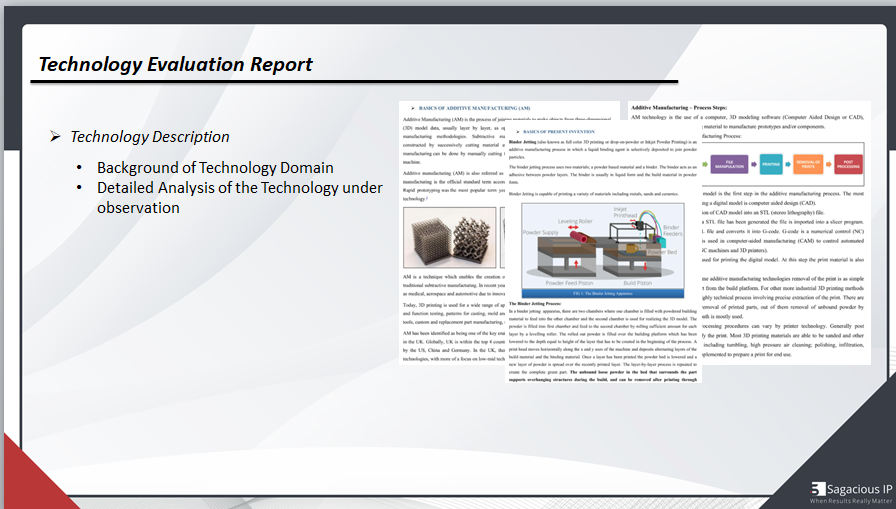
So in technology description. Firstly, a background of the technology will provide you. That is, in the case of the binder jetting process that we are taking an additive manufacturing is the background detail about additive manufacturing. Okay, and after that, the report will focus on this specific technology. That is the final setting process.
The researcher can also connect with the inventor of the technology to better understand his point of view on the technology as well. Better create this report. Apart from the secondary sources, he can also directly connect with the inventor of the search. So that detailed analysis or detailed report is created.
Potential Benefits
in potential benefits, unique selling points or advantages of that particular technology is provided. Now here you can see on the right-hand side, are editor manufacturing and conventional manufacturing processes.
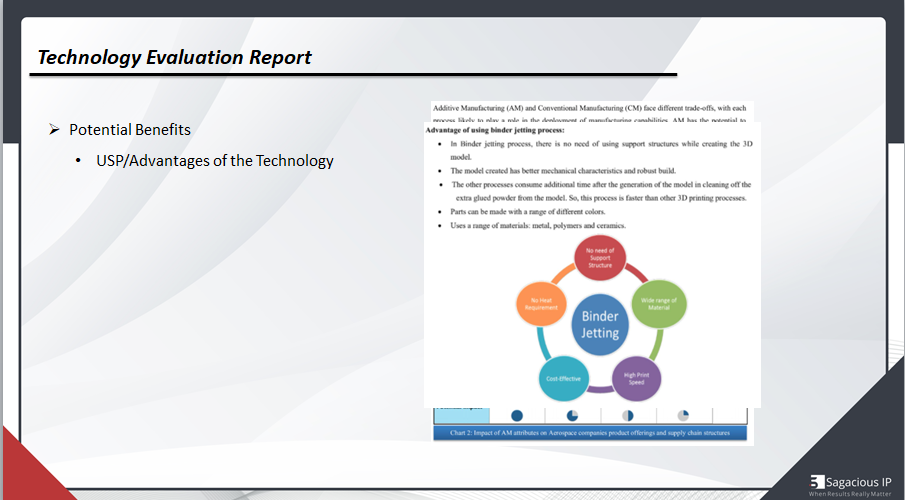
So how are the additive manufacturing process advantages over this convention manufacturing process? What is the unique selling point of that additive manufacturing? So this covers detail about the general or domain only. For example: Binder jetting processes, the USP or the information or the advantage of that binder jetting processing.
Potential Market

Firstly, market research can be broader or narrow-based on the domain. So broader research is done for the domain of the technology that additive manufacturing the narrow search will be for the binder jetting process. That is the narrow market searcher because if various manufacturing procedures are there, so you can search for the market as a whole as well and for that particular technology also. So the market difference will cover both those points.
Geographical Analysis
This kind of geographical mapping analysis will help you identify will help any business identify where is the innovation coming from in this particular domain. So there is a patent finding being done mostly ways the grant that is a contract for those technologies.
As you can see in this example for bandage getting the main technological innovation of from the USA and Secondly is from Russia and then Europe.
The second is from China and then the Euro region as well. Okay, European unions. So these are the primary innovative areas for these particular technologies.
For any technologies. This will help you identify the market as well. So here you can take the technologies. IP insights can help you identify a proper market for commercializing, those technologies as well.
Companies and Products
Technology Evaluation Report will help a business identify existing companies that are working on that particular technology or that are using similar technologies or that exist in the domain. And the products that are there currently using technology evolution will cover those products in detail as well so that the business can see what their USP or what is their competitive as of this particular product.
And what is the advantage of the technology of that particular technology that is currently being employed in the market or currently being used by the competitors? Those are key opportunities and application areas.
So how a Technology evaluation report helps a business identify key opportunities and application areas. where the technology can be applied. Okay, so in the case of binder, get can be applied in printing, energy sector, medical and rental sectors, electronics, automotive error, space, and defense.
Okay, so these are just a few examples of the applications and then the Technology evolution report will cover this domain in detail as well.
How this domain will use that particular technology or how the technology can be used in this particular application areas that should be covered in the Technology Evaluation report.
Risk and Barrier

The first is the existing intellectual property. So if you have a technology, and you are going to market the technology, you’re going to commercialize the technology. You are going to launch that particular technology or that business is going into a new venture.
Okay, so you might want to launch a new technology or the business wants to create, use the technology in the domain or commercialize that technology, then they need to check
what kind of intellectual property or exist in the domain that might act as barrier to entry into the market.
Okay, so Technology Evaluation Report will provide details about the existing intellectual property, though specific FTC will be more element Intel Technology Evaluation Report will provide an existing terrestrial property section that might Act as a barrier for the particular commercialization, the technology.
The Technical Challenges
This will cover shortcomings as well. So these technical challenges will Act as a barrier for that particular technology when entering into the market.
And these technical challenges need to be overcome. And these reports will help you identify these challenges. so that this can be overcome by the business or by the inventor or by the startup founder,Anyone that is using a Technology evaluation report
Recommendation and Next Steps

So based on the information that is provided to go over based on the information that is provided in the Technology Evaluation report, the resistor will provide you a recommendation, final recommendation, or his conclusion or his final point of view.
What kind of steps should be taken next? Okay, so the recommendation might include licensing opportunities as well. In case, the inventor has an IP particular innovative technical up, so he can provide licensing to license to other competitors in the domain.
In case he does not have any IP, he can take a license from those particular computers or those particular key players that have IP in the domain before entering the market.
Yeah. Also, it can provide your strategy on how to proceed with your product launch and what kind of pricing should be there for that particular technology or timing of that?
The launch product out of markets that shall be targeted by the business of that particular technology, either to be successful in the market or the target consumers that should be approached for that particular technologies. The data provided in the Technology Evaluation report can also be used by the inventors or the startup founders to create an investment page book.
Okay, so they can use this data to support their agreement. Is that the technology viable or not? Or why should anyone invest in the technologies? So the use of these resources and data will help them create an investment Ebook.
That will help them in creating, getting funding and other these are the sections that a technology evaluation report should cover and how Technology evaluation report will help a business. So this is from my end in case you guys have any questions you can ask me right now.
Q&A Session
Faiz speaking: great, thanks.
I can see some questions flowing in so I can get started while others are invited to share their questions over into this. So the first thing I wanted to ask you, I think you shared a very interesting for some of the results, the case study that you shared when our smart audience voted against investing in that idea, which you showed that failed, later on, 67% of the audience voted that they will not invest in it.
It shows two things, 1 is the smartness of our audience, but also it shows what you, later on, shared about this technology evaluation report that the primary research can help in identifying whether that particular product is needed in the market or no. Let me come to my first question that one of our participants is asking.
Question 1. What is the relevance of intellectual property in technology evaluation report? Is it around that? Is it done around a particular patent, or is it like on a particular technology, and then it can assist different patterns or how.
Yogesh answers: okay. So the interaction property, I think, plays an important role in a technology valuation.
So it is not around a particular created rather than a particular domain or particular technology. It can help us identify the already existing technology or the already existing rights in the domain. So that will act as a barrier when the technology is being commercialized. We need to identify those in the early stages so that we can particularly license or technologies or design around those technologies. So that should be covered in a technology evaluation report and it will play an important part in the success of the particular technology.
Question 2. Is there a specific time when these kinds of studies are conducted during the life cycle? Like maybe at a very early stage when you have an idea immediately, you go ahead and do a technology evaluation report or it is ahead in the life cycle. When you have developed something tried tested out, and then you do a technology evaluation report, what is the right time to do a year.
Yogesh speaking So I think the technology evolution report can be conducted at any time, but the best time will be to conduct a technology evolution report before the idea is perceived as a final product or before.
The idea is starting so that you can identify the problems that will we assist in the future so that you can work on those ideas and you can also access the value of the technology, whether it is viable or not, whether it is so that business should invest in that particular technology or not, because the business has limited resources and power. But in case It’s already started with the idea. Then also we can conduct a technology evaluation report to see where their ideas looking or where the technology is looking.
Question 3. When you’re creating these insights from intellectual property, how are those insights created? How do you really make sense from so much literature out there, as I told you that we will identify the patents or the intellectual property around the technology?
Yogesh speaking: okay, so from that pool of technology, we will create some insights that insights can be from the market area, how those technologies or those patents are spread over the world, where they’re originating from, where they’re being filed later on.
Question 4. How is this report different from a market research report? Is it just that because you are accessing patent data, that’s why it is different. Or are there other pieces of data sources or data intelligence that you gather in this kind of report?
Yogesh speaking: So this report is considered a part of a marketing evaluation report. But apart from the market evaluation report, we also consider the technology of face.
We also considered the IP, as you have said and we also provide detail about the technology and the technical challenges of that particular technology. That is why we are saying it is a technology evaluation report. We are assessing the value of that particular technology rather than just identifying the market for that particular technology. So that is why it is considered as a technology evaluation report rather than just a market evaluation report.
So the market is a part of this report technology evaluation report. But it is not the only part of this in the report. It also covers technology evaluation, technology challenges, and the IP domain in this report.
So you’re saying this will also include market challenges as well?
Yes. So it will consider market evaluation factors as well.
Question 5. in one of your slides, you showed the primary and secondary search. And in the primary, you said surveys and you talked about interviews and stuff. So how are these interviews conducted? Are you talking to people or users or experts? What kind of interviews are these?
Yogesh speaking Sagacious conduct these kinds of interviews. They have a long list of affiliations, and we contact those technical experts in a particular technology, and we conduct those interviews. We take the onus opinions and we try to incorporate them as soon as possible, and we try to incorporate them directly in the report.
So we conduct those interviews with the real inventors, the real technology experts, by a user of our initiatives. You also conduct services as well within the company, also from databases or we like every other source.So we can get to know where sure, we can get to know the information about the particular technology or the opinion of the community. we conduct the primary search on our own by use of our initiatives. Okay. And such a report, the technology Evaluation report.
Question 6. Is this also helpful in Whitespace analysis for a specific technology? And if so, then how?
Yogesh speaking: in identifying a Whitespace, I think landscape searches will be more efficient. So landscape search will identify the white space more easily.
In this particular technology evaluation report. We might be able to uncover some insights on the white space but it will not cover all that should be covered in a Whitespace analysis for a specific technology. Because for considering a white space technology, we will have to map all the technology patents that are provided in that particular domain so that we can know what kind of technologies has not been covered by those patents
Question 7. So how is a Whitespace analysis actually different? Is it kind of a subset of this or is Whitespace analysis more comprehensive and kind of undertaken separately than technology evaluation reports?
Yogesh speaking Whitespace analysis focus specifically on the intellectual property only. So it is more comprehensive than technology evaluation report. We call it technology valuation, record, recorded links, or general idea of the techno patent that exist in domain. There is a landscape. We cover all the patents that there is in the domain and then based on that landscape, you can identify the white species in that particular technology.
Technology evaluation report will just give a glimpse of maybe some white spaces that might exist or some ages and see if that might exist around this particular technology.
So that in case a decision maker would want to create a pivot or discontinue putting efforts in a particular technology domain while increasing their efforts in another technology domain. So that’s the level of information that will be available.
You will also have market details about and use the feedback and other observations also included in the report. It’s a more holistic picture of the evaluation rather than just a patent oriented picture or a patent driven picture of the technology.
Question 7. How do you really help someone understand or identify whether this product is important or not? Is that really done through some kind of user studies or how do you really do whether there is a market for this product or not?
Yogesh speaking So first, to identify if there’s a market for the particular technology or not, we conduct surveys. We ask some questions. will you invest in this technology or not? Will you be interested in the technology or not? So that kind of surveys we conduct so that we get to know that what is the opinion of the community or the people or the society in which the technology will be marketed or will be presented?
We also conduct consumer service to identify if there is a need or want for that particular technology.
Also, we use secondary resources. we identify similar technologies that have been deployed, and was there a need for the specific technologies and we will use those data as well in supporting our argument.
Faiz Wahid speaking Right. So I think you’ve covered a lot of ground you. I think we had a good discussion to have a lot of questions also coming in.
Question 8. Why is it so important to conduct an early technology evaluation study for any innovative business idea? Why do you want to why should we conduct it early? I understand that probably, you know, if you do it too late, then probably you have spent too much time and money behind it. But there are any other reasons why someone should think of conducting it at an early stage.
So we have put in this as only as you conduct a technology evaluation report, you get to know if you should pursue with an idea or not, that is the main aspect, even if, in case you are conducting technology evaluation report at a later States and you identify that your idea is feasible, then it’s okay.
You can continue with the idea, and it will not impact the course or the time of the particular course on that idea.
But in case you identify on later stage that the idea is not visible, and then you abandon that idea, then you have already spent a specific amount of time or resources and costs on that domain which could have been used on any other idea that was more accessible that was more viable than particular technology. So, if late technology evaluation report will help you identify to choose the best technology or the best technologies that will be viable or that will provide your best return of investment.
So in case business is going to invest in a group of technologies, okay, so if they conduct technology evaluation report, they get to know which technology will get the most return on investment and they can use their limited time and resources on that particular technologies.
Question 9. Is this report just a one-time feature in the lifecycle of a project? Or do you generally recommend it to be done from time to time, like after a year or two year or something like that?Of course, that would be but too long a time for that idea to germinate and develop. But do you see clients coming back for such kind of report on the same project ideas like in six months time or one year time?Or is it like just one of its kind study for one project once? Do they get to know the changing perspective of the audience, what kind of new data is provided over and what has changed in the market?
Yogesh speaking: so the technology evaluation report update can help you identify the changes in the market so that you can adapt to those particular changes. So you should start a technology evaluation report at the start of the technology and ideas also. But during the course of the idea as well, so you can identify the changing market or the consumer perspective the course for that might be needing.
But the technology evaluation report will help you identify the changing course or the changing consumer points or the changing market. So the technology evaluation report could be conducted quite a time in the lifeline of an idea or a project
Faiz Wahid speaking: but what you are also saying also indicates that if we are conducting a study, Let’s say a company is doing this in house and they’re in some form, everybody is kind of evaluating or creating sub report, etcetera.
Do you also see clients coming? Let’s say, to Sagacious or any other third party providers to get this view because they were want the third party view of how this technology will be even against their internal evaluations.
Let’s say, get it done from someone else so that we see what is the external perspective on it is when a person or resource is conducting a technology evaluation report, this somehow have a kind of an already created an opinion on. If they’re going to use a technology as they are work on that particular technology that you might be, I drive that report in that particular direction.
So third point of view will definitely be best way to conduct a TER so that you can create a more holistic report and that is not tainted by already planted idea in a research.
So third party view is mostly why business conductor third party views rather than conducting it in house, so there’s no prejudice among the researchers.
Faiz speaking: all right, and overall, in this report in this discussion, and I think these questions also from the participants were hinting towards how important is the IP angle in all this report, the intellectual property angle, and is it reliable and a useful measure for whenever you are evaluating a technology?
Yogesh speaking: so yes, it is a definitely a major factor in evaluating a technology because it will identify is there a market need for less technology?
So in case you see that there are many patents being filed in a particular technology, you will see that most people are working on the technology. Let’s just say an example of additive manufacturing of it. So start initially, there was very good patents in the domain, and the domain has increased to such an extent as a regular filing in this particular domain.
So it will showcase the how should it will showcase the interest of the domain interest of the market in that particular technology. That is why they are investing in that particular technologies. So the patent Front will also somehow showcase the market interest.
Faiz speaking: and what you’re suggesting is that even the patent trends. And even, for example, if in a particular industry, you find that there are patents which are being litigated too often, then that also indicates that this is like a hot domain.
Yogesh speaking: yes. Also, IP insights will definitely provide inside to the technology evaluation. And the market evaluation i
Faiz speaking: wonderful. I think Yogesh have covered a lot of ground on this.
So this has been a wonderful session. I’m sure our listeners have great takeaways from the session, and we’ll be able to use several of these pointers when they are evaluating technologies within their businesses or within their workplaces, we have not been able to address all the questions that we have received.
I have tried to kind of summarize and covered most of them. I think we have covered almost all the topics and the aspects that we wanted to cover here.
And as I mentioned earlier, if anybody would like to have some more details or have any discussions, or would like to see that example report can be shared with the participants if they needed you to report that you were showing as an example.
Yogesh speaking: yes, we can show that example report if they want, they can.
Okay, sounds good that maybe people would want to kind of take a deeper look into what you shared and understand further from the context that you have provided.
So if anyone is interested, please, drop an email at [email protected] mentioning today’s webinar and that you would like to receive the example report will be shared as Yogesh has consented to share it.
So that would be a good thing. Also, I would want to extend a very big thank you everyone who has helped us in starting the webinar on time and finish early. We have four minutes early, so we highly appreciate that and thank you so much.
Thank you, Yogesh, for joining in and sharing your valuable knowledge and insights in audience has. Thank you so much and please do join us in our next webinar. Have a great day ahead. Thank you, everyone, for holding your time.
Have a great day.


